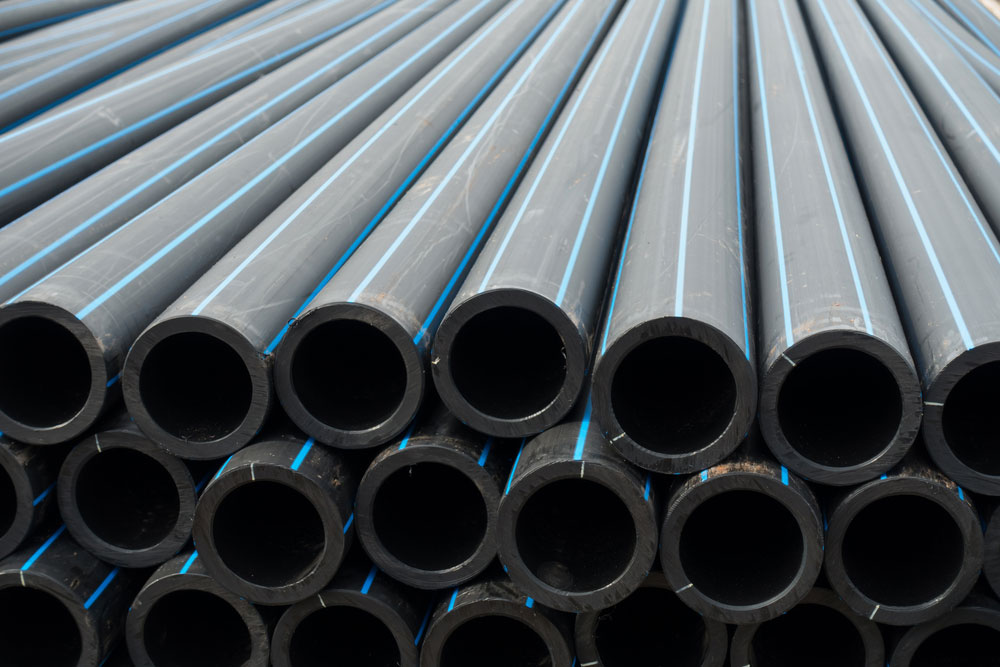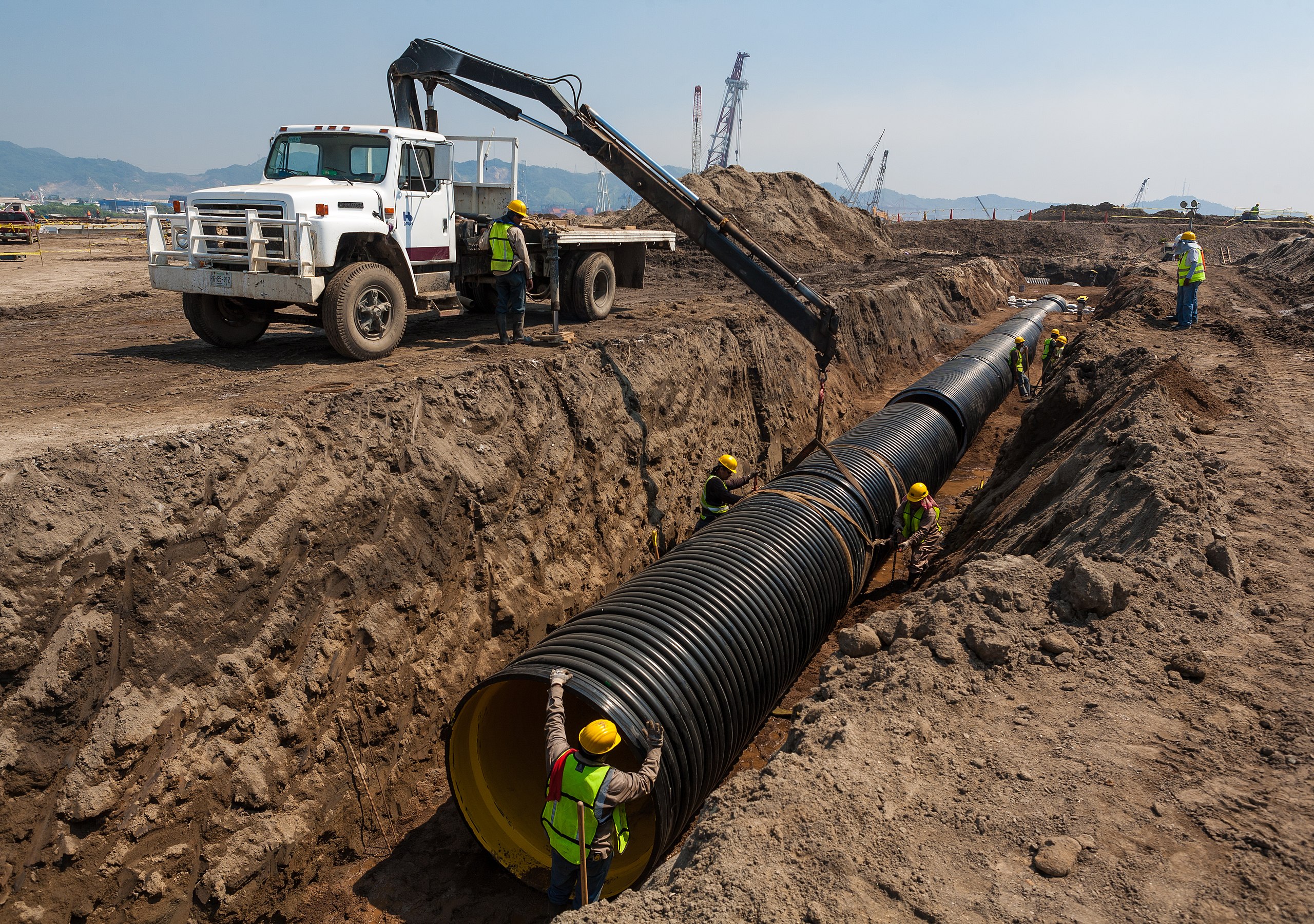Why Texas hdpe pipe manufacturer Is Dominating in Quality Production
Wiki Article
Explore the Production Refine Behind High-Quality HDPE Pipeline and Its Applications
The manufacturing procedure of top quality HDPE pipes is detailed and methodical. It starts with the option of raw products that enhance performance. Following this, ethylene undergoes polymerization to develop material, which is then shaped with extrusion. Quality assurance is paramount, ensuring that the last product satisfies stringent criteria. The trip of HDPE pipelines doesn't end with production. Their applications throughout different industries reveal a more comprehensive significance worth checking out.Understanding HDPE: Residences and Advantages

High-density polyethylene (HDPE) is a versatile polycarbonate known for its durability and resistance to various ecological elements. This material shows exceptional tensile stamina, making it ideal for demanding applications. Its low-density framework adds to a lightweight product, facilitating simplicity of taking care of and installation. HDPE likewise showcases impressive resistance to chemicals, which minimizes destruction when exposed to harsh compounds.
The material's reduced wetness absorption better enhances its long life, making it optimal for use in pipes and storage tanks. Furthermore, HDPE is resistant to ultraviolet (UV) radiation, making certain that products preserve their honesty even when revealed to sunshine. Moreover, its adaptability permits for the production of complex shapes without jeopardizing strength. The eco-friendly nature of HDPE, frequently acquired from recycled materials, includes to its allure, advertising sustainable techniques in manufacturing. Overall, these homes and benefits make HDPE a favored choice for various industrial and customer applications.
Resources Option for HDPE Manufacturing
The option of resources for HDPE production is important to validate the end product satisfies the preferred specs and high quality standards. High-density polyethylene (HDPE) is mostly generated from polymerized ethylene, stemmed from fossil gas such as gas or petroleum. The top quality of these feedstocks substantially affects the mechanical and thermal residential or commercial properties of the last HDPE.Ingredients additionally play a considerable duty in enhancing HDPE's efficiency, consisting of antioxidants, UV stabilizers, and colorants, which enhance sturdiness and resistance to environmental variables. The option process must take into consideration not only the chemical structure of the raw products however likewise their processing attributes to assure reliable production.
In addition, the sourcing of resources should focus on sustainability and conformity with ecological laws, as accountable practices are necessary in today's market. Ultimately, cautious resources choice lays the foundation for producing high-quality HDPE pipes appropriate for diverse applications.
The Extrusion Refine: Forming HDPE Pipe
The extrusion process plays a crucial duty fit HDPE pipelines, starting with careful product prep work techniques that guarantee optimal circulation and consistency. Just as crucial is the layout of the die, which directly affects the final dimensions and surface quality of the pipeline. Together, these aspects contribute considerably to the performance and high quality of HDPE pipeline production.Product Preparation Strategies
Reliable production of HDPE pipelines starts with careful product prep work methods, specifically the extrusion process. Throughout this phase, high-density polyethylene material is first dried to eliminate dampness, ensuring optimal circulation characteristics. The material is after that fed into the extruder, where it undertakes home heating and melting, changing into a viscous state. This home heating process is meticulously controlled to keep the material's stability and performance. The molten HDPE is forced with a die, shaping it right into a constant pipeline kind. Proper temperature monitoring throughout extrusion is crucial, as it directly influences the product's buildings and the end product high quality. As soon as formed, the HDPE pipeline is cooled and reduced to defined sizes, all set for subsequent handling and applications.Die Design Significance
Accuracy in die style plays a vital role in the extrusion procedure of HDPE pipelines. The die works as the last shaping device, straight influencing the pipe's dimensions, wall density, and surface area coating. A properly designed die guarantees uniform product circulation, lowering flaws such as abnormalities and weak places. The geometry of the die have to be optimized to accommodate the particular buildings of HDPE, including its thickness and thermal habits during extrusion. Additionally, the cooling rate of the product as it travels through the die can markedly influence the pipe's architectural stability. Investing in innovative die innovation is vital for producers aiming to generate top notch HDPE pipes that satisfy industry standards and client assumptions.Top Quality Control Actions in HDPE Manufacturing
Different variables influence the top quality of HDPE pipe production, effective top quality control actions are vital to assure consistency and reliability in the final product (Texas hdpe pipe manufacturer). Key high quality control techniques include extensive product examination, confirming that the raw polyethylene fulfills established requirements for purity and thickness. Throughout the extrusion process, parameters such as temperature level, stress, and cooling time are carefully checked to maintain dimensional precision and architectural stabilityIn addition, post-production screening is essential; producers typically conduct hydrostatic examinations to assess the pipe's strength and resistance to stress. Aesthetic inspections for surface area flaws additionally boost quality assurance. Certification from relevant criteria organizations, like ASTM or ISO, supplies an additional layer of credibility. By implementing these comprehensive high quality control actions, suppliers can reduce flaws, improve efficiency, and visit the site make sure that the HDPE pipes satisfy the certain requirements of numerous applications, eventually resulting in customer complete satisfaction and trust in the item.
Applications of HDPE Pipeline Throughout Industries
HDPE pipelines are used throughout different markets because of their durability and versatility. In water circulation systems, they assure efficient shipment, while in wastewater management, they supply trustworthy options for waste transportation. Additionally, farming irrigation networks gain from HDPE's resistance to deterioration and flexibility, making it an ideal option for modern-day farming methods.
Water Distribution Systems
A substantial number of markets depend on high-density polyethylene (HDPE) pipes for effective water distribution systems. Known for their resilience and resistance to deterioration, HDPE pipes are extensively used in local water system networks, farming irrigation, and commercial applications. Their lightweight nature facilitates simple handling and installment, lowering labor expenses and time. Additionally, HDPE pipelines can suit numerous pressure levels, making them appropriate for both reduced and high-pressure systems. hdpe pipe suppliers Midland TX. The adaptability of the material enables smooth combination right into existing facilities, lessening the need for considerable excavation. HDPE's resistance to chemical seeping guarantees that the water supplied stays safe and tidy, making it an excellent selection for keeping the high quality of safe and clean water across various fields.Wastewater Administration Solutions
Effective water circulation systems likewise lead the way for innovative wastewater administration services, where high-density polyethylene (HDPE) pipes play a significant duty. Distinguished for their durability and resistance to corrosion, HDPE pipelines are ideal for moving wastewater in various setups. Their versatility permits easy setup in complex settings, minimizing the requirement for comprehensive excavation. Additionally, HDPE's smooth interior surface area minimizes rubbing, boosting circulation rates and performance. These pipelines are likewise resistant to chemical leaching, guaranteeing that contaminants do not compromise the surrounding environment. Industries, communities, and treatment facilities progressively count on HDPE pipelines for their dependability and longevity, making them a preferred choice for modern wastewater management systems. This adaptability underscores the crucial importance of HDPE pipelines across many applications.Agricultural Watering Networks
Agricultural watering networks benefit substantially from making use of high-density polyethylene (HDPE) pipelines, which provide effective and reputable water shipment to plants. HDPE pipes are light-weight, making them simple to deliver and set up, while their versatility enables for various setups in varied surfaces. These pipelines show excellent resistance to corrosion, chemicals, and UV radiation, making certain sturdiness in rough agricultural atmospheres. In addition, their smooth indoor surface decreases rubbing loss, maximizing water flow and lowering power prices associated with pumping. The durability of HDPE pipes, usually going beyond 50 years, adds to reduce upkeep and replacement expenditures. Subsequently, farmers progressively rely on HDPE pipelines to enhance watering effectiveness and promote lasting farming methods, ultimately leading to improved plant yields and source conservation.Future Trends in HDPE Pipeline Technology
As the need for sustainable and reliable facilities grows, improvements in HDPE pipeline innovation are poised to change different industries. Emerging trends include the assimilation of clever technologies, such as sensing units and IoT capacities, which help with real-time monitoring of pipe conditions, reducing upkeep costs and protecting against leaks. In addition, the growth of advanced production techniques, such as 3D printing, is making it possible for the manufacturing of facility, tailored pipe styles that accommodate specific job requirements.Furthermore, the focus on recycling and circular economy methods is driving the advancement of HDPE pipelines made from recycled products, enhancing sustainability. Enhanced jointing methods, such as electro-fusion and mechanical fittings, are additionally boosting setup efficiency and dependability. Ultimately, the growing focus on environmental regulations is pressing Learn More suppliers to adopt greener production procedures, guaranteeing that HDPE pipes not just fulfill sector criteria yet likewise foster a more sustainable future for facilities development.
Regularly Asked Questions
How Does HDPE Compare to Other Plastic Materials?
HDPE surpasses several various other plastic materials pertaining to sturdiness, chemical resistance, and flexibility. Its low thickness and high tensile toughness make it optimal for numerous applications, typically exceeding alternatives in both efficiency and durability.What Are the Environmental Impacts of HDPE Manufacturing?
The ecological impacts of HDPE manufacturing include greenhouse gas discharges, energy intake, and prospective contamination from making processes. Additionally, improper disposal natural gas pipe fittings can result in soil and water contamination, elevating issues regarding long-lasting environmental results.Can HDPE Pipeline Be Recycled?
Yes, HDPE pipes can be reused. Numerous facilities accept utilized HDPE for processing, changing it right into brand-new items. This reusing adds to sustainability initiatives, decreasing plastic waste while conserving sources and power in the production cycle.What Is the Life-span of HDPE Pipeline?

Just How Do Temperature Variants Influence HDPE Pipeline Performance?
Temperature level variants greatly influence HDPE pipeline efficiency, impacting flexibility and toughness. High temperature levels can lead to softening, while low temperatures might trigger brittleness, eventually influencing the pipe's resilience and viability for different applications in diverse environments.Report this wiki page